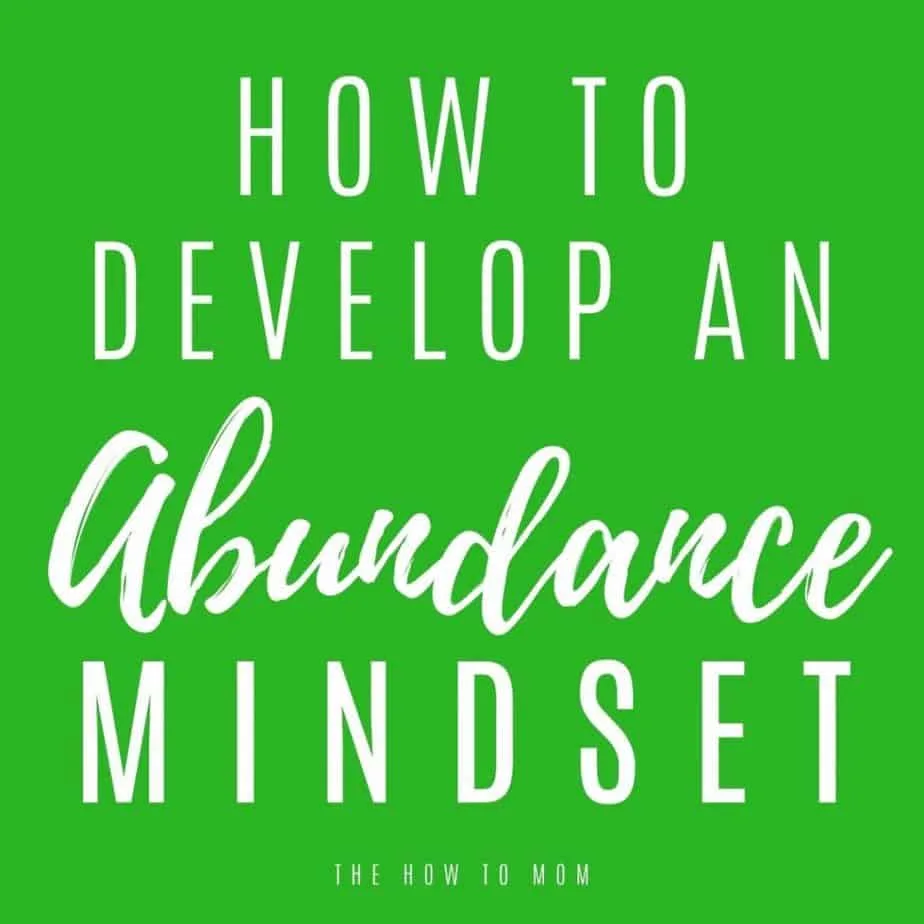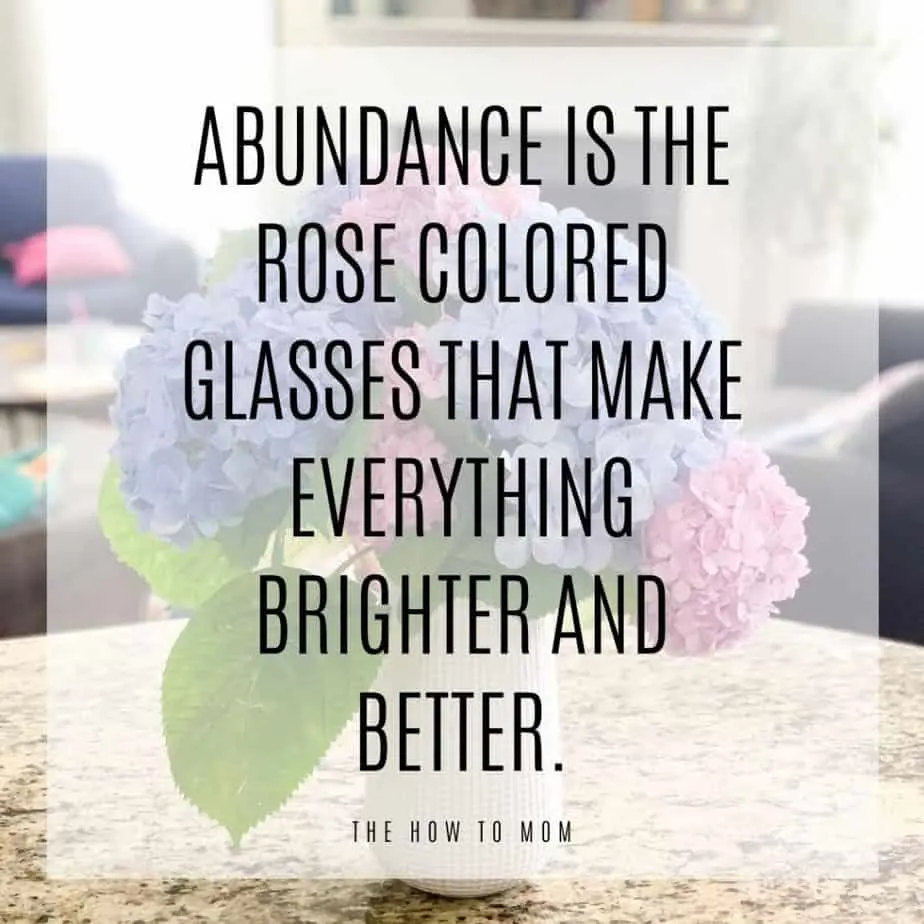- How to Make a Burlap Wreath – 3 Easy Styles! - May 30, 2022
- How to Revive Wilted Hydrangeas – Guaranteed! - July 28, 2021
- Easy Canvas Painting Ideas – 30+ DIYs for Beginners - June 16, 2021
Transition your thoughts from fear, worry and scarcity mindset to peace, confidence and abundance mindset with these 12 simple steps.

One day it hit me that “We always struggle to make ends meet” and “We somehow make it work” are basically describing the SAME THING. Same circumstance of having basically enough, but two completely different perspectives.
Mind blowing, right?!
“We always struggle to make ends meet” feels hopeless and frustrating and depressing.
“We somehow make it work” feels empowering and hopeful and content.
Its the perfect illustration of the difference between scarcity mindset and abundance mindset. Nothing in the situation or circumstance changes at all, but the subtle shift in how we look at it changes EVERYTHING.
What does scarcity mindset look like?
A few months ago, we were watching a summer thunderstorm roll through with a married couple we’re friends with. The husband confided that he feels an overwhelming desire and pressure to provide a better life for his kids than what he had growing up. He lamented that he isn’t able to take his kids on amazing vacations or own a boat to be able to spend Saturdays on the lake as a family.
As he talked, I couldn’t help but think, what in the world is he talking about?! He currently is on an amazing and memorable vacation! In beautiful Charleston, SC! They actually are spending Saturdays on the lake with two boats this summer while they’re visiting their extended family. He actually does live in a significantly nicer home than the one he grew up in. He is driving nicer cars than his parents, and is enjoying occasional splurges on premium clothes and expensive dinners out.
And yet he couldn’t see any of it.

Scarcity mindset is a sneaky thing. People that are “in” a scarcity mindset have no idea that they are.
It just feels like reality.
By definition, scarcity is where there isn’t enough of something. Typically, the term is used in economics to explain the problem of having limited resources and limitless demand. But the term can be applied to more than resources or money. People can experience scarcity in relation to time, energy, love, patience, support, information, success, food, or any number of areas. Any area where you feel there’s “not enough”.
What does abundance mindset look like?
By contrast, abundance mindset is the understanding that there is always enough. More than enough! There is plenty of money in the world, enough time to do what is truly important, enough information to learn anything, enough energy to accomplish whatever you want.
It’s not a bunch of woo-woo either. Living in an abundance mindset doesn’t mean walking around in la-la land with your fingers in your ears, ignoring reality. It means choosing to give peaceful and confident thoughts priority over the anxious and fearful ones. It means choosing to think grateful and hopeful thoughts instead of indulging in thoughts of not being or having enough.
What is scarcity mentality vs abundance mentality
Stephen R. Covey first coined the term “abundance mentality” in his bestseller, The 7 Habits of Highly Effective People when he talks about the concept of “Win-Win” in Habit 4. He explained that people generally think in a scarcity mentality, that succeeding comes at the cost of someone else losing. If one person gets more, that means another person gets less. A zero sum game, that there is always a winner and a loser.
Obviously, these scarcity thoughts cause feelings of fear, stress and discouragement. They cause us to feel anxious and worried that we may not get what we ultimately desire. Scarcity mindset leads us to fear that there won’t be enough for us.
Abundance mentality, however, comes from a deep sense of security and a belief that there is enough for everyone. That not everything is win-lose, but that you can actually find win-wins. That one person’s success can buoy up a whole group of other people along with them.
Abundance thoughts create feelings of gratitude, peace, and happiness. When we think with an abundance mindset, we are confident in our ability to prevail and succeed. We feel peace knowing that there will be enough for everyone.
You don’t have to be wealthy to have abundance
It would be easy to assume that scarcity is a problem that only poor people have to deal with, but surprisingly that isn’t the case. In The Soul of Money, Lynn Twist shares many examples of extremely wealthy people that live in scarcity, worried about losing their money or not being able to keep up. She also points out the millions of people around the world living in poverty, but managing to feel happiness and peace.
Contrary to assumptions, abundance and scarcity isn’t about math, its about thoughts. The thoughts will stick, even if the numbers change. If you are stuck believing that you don’t have “enough”, you will never have “enough”. It just doesn’t exist. So while it might be useful to find ways to increase your income, chasing the money might just be perpetuating the “not enough” cycle.
Why do we get stuck in scarcity mentality?
Confirmation bias can keep us proving our old thoughts and beliefs. Studies and statistics can be used to prove either side, and when we are stuck in scarcity, unfortunately we end up using those facts against ourselves to keep us miserable.
But when we are actively focusing on what we want to see or believe, those biases can change. We can start seeing things in a new light. But it does take a conscious effort to fight those confirmation biases.
How to develop an abundance mindset
When I first started trying to transition from a scarcity mindset into an abundance mindset, I totally googled “How to get out of a scarcity mindset” and was fairly disappointed at the resources available. I wanted tips and ideas from a REAL person, not a psychology journal. Someone who has actually made the transition from scarcity to abundance. Someone like ME, a late 30’s middle-class mom of three.
As I did the work of cultivating an abundance mentality, I took note of what helped and what was just woo-woo or ineffective. I’d say the process took about 6 months of focus. I saw immediate improvements in my level of contentment and happiness due to my efforts, but occasionally the scarcity mindset would creep back in unexpected ways. So I would have to identify it and work to untangle the thoughts in the new area to get back to abundance.
I don’t think its possible to live in a fully blissed-out, zen-like continual state of abundance. Unless you’re a monk, perhaps. But I do think that any effort in moving towards thoughts and feelings of abundance has positive repercussions, and even if we encounter set-backs, abundance is available to us any time we seek it.
How’s that for meta: you can have abundance mentality about having abundance mentality!
Top 12 tips for developing an abundance mindset
The trick to believing a new thought is figuring out how to prove it to yourself. That’s it. You just need to effectively convince yourself that you actually have enough, or more than enough. So I’ve come up with 12 small ways to give you a little momentum towards believing new thoughts about abundance.
1. Daily gratitude/abundance thoughts
This is number one on the list for a reason. It has such a huge impact when done, even short term or infrequently. People tend to roll their eyes when you suggest “gratitude” as a solution for their problems (be honest, you probably did too!), but once you try it and witness the results, you get it. It may sound trite, but its so so powerful.
Research tells us that gratitude is strongly and consistently associated with greater happiness. According to Harvard Medical School, “Gratitude helps people feel more positive emotions, relish good experiences, improve their health, deal with adversity, and build strong relationships.” Sounds like an abundant life!
Habits related to gratitude can be learned and increased. I find that the best time for me to incorporate gratitude is during my morning routine. Taking a few minutes in the morning to journal what I’m grateful for helps to train my mind to look for the good things during the rest of the day.
I also use a daily gratitude app for quickly jotting down positive thoughts and interactions throughout the day, and I have it set to appear on my lock screen to encourage more grateful reflection throughout my day.
Prayer or meditation is also an excellent way to increase feelings of gratitude and abundance. I have been meditating consistently for almost a year now with the Headspace app and have seen enormous positive benefits from it. Abundance and gratitude are part of the core philosophies of meditation.
2. Donate more stuff
I was excited to put this one on the list, because it seems so unexpected. How can donating stuff help me feel more abundant? Well, when we look for things to donate, we are identifying things we don’t need or “excess”. Excess, by definition means more than enough.
When we start collecting items to donate, we are faced with the physical proof that we in fact do have “more than enough.” We have abundance.
Whether its embarking on a big seasonal declutter and purging spree or simply establishing a habit of identifying and removing what we no longer need, donating our excess helps us to recognize that we already have what we need.
When we realize that we have what we need, we are filled with feelings of peace, contentment, gratitude and abundance.
3. Clean your house
Another unexpected tip, cleaning your home can help you cultivate feelings of abundance. Clearing away clutter and cleaning counters and tabletops bring more peace into our space. Its much easier to love the home we’re in when its clean!
Considering that scrubbing and vacuuming is basically exercise, cleaning releases endorphins. Endorphins reduce stress and anxiety, and can cause a bit of a euphoric state. Its much easier to feel abundant when you’re feeling a bit euphoric!
When we care for what we have, its easier to feel grateful for it. If done right, dusting off those family pictures and nic-nacks and souvenirs from past vacations can help us cultivate positive feelings and memories.
Lastly, when our home is clean, its easier to love it as it is. Our eye isn’t drawn to things that annoy us or bring us down. Its easier to not be so critical when our space is neat, tidy and clean.
I remember learning this concept one day as I was complaining to my mom on the phone about the idiosyncrasies of my home. An interior decorator at heart, my mom gave me a few suggestions. I agreed with her recommendations and set out to clean up the area so that I could start the redecorating project. But once it was clean, I suddenly realized that it wasn’t so bad as it seemed before. It just needed a fresh cleaning.
4. Make tiny adjustments towards ideal
This tip follows next in line from taking care of our homes. Chances are there are a handful of small improvements you could make to your home, budget, schedule or family life, that could create some momentum to start feeling more abundant.
I have a friend who had to downsize to a townhouse after a move to a new city. She disliked the place and hoped it was temporary, but after a few years she began to accept that she would likely be living there for at least a few more years. So she decided to start doing what she could to make it look and feel more like what she prefers. She bought a new rug, decluttered a bit, recovered a couch and built some shelves. She was amazed at how much happier she felt at home and no longer resented where she was.
Our situations might not be what we want, but there are likely a few things that could be done to get it one step closer. I’m not talking about complete overhauls, it can be as simple as buying a few new throw pillows or keeping $20 cash in our wallet, to help us recognize that we actually do have money. By taking small steps towards our desires, it becomes easier to believe we have what we want. We can guide our thoughts towards that abundance mentality.
5. Use abundance affirmations
Affirmations or mantras are a very effective way of transitioning to an abundance mindset. Yes, they can feel a bit awkward at first, but the science backs up the theory that positive affirmations reduce negative thoughts, and help us develop more hopeful narratives about ourselves and our potential.
Affirmations are most effective when repeated regularly, at least daily, if not a few times a day. Incorporating writing or repeating affirmations during your morning routine would be a great starting point.
8 Abundance Affirmations to Try
- I attract success
- I am open to wealth and success
- God (or “the universe”) is always blessing me with what I need
- I will always have what I need
- I can see abundance easily
- I love money and money loves me
- I am worthy of the success I desire
- I am proud of myself and all I have accomplished
I put together over 75 of my favorite abundance affirmations here, along with easy printables to get you started.
6. Get some perspective
Chances are that if you’re reading this, you are likely living in the United States or another first world country. Which means you have fresh running water, reliable electricity, and a fridge with food in it. Most of us have smart phones, multiple TVs, cars, and access to good education and health care.
We actually have a lot. We definitely have abundance in comparison.
The standard of living in the Unites States is one of the highest in the world. Middle class and poor families in America are, on average, still richer than their counterparts in other countries.
Our perspective quickly shifts when we consider what we have in comparison to millions of people living in poor conditions around the world.
7. Find small, joyful splurges
This might not be what Dave Ramsey recommends, but small occasional splurges can have a big impact on our mental health. Often when we are striving to reach our financial goals, we go into scrimp and save mode. And feelings of scarcity go hand in hand with budgets and reducing expenses. Its hard to feel abundant when we continually tell ourselves we can’t afford anything extra.
In the book, All the Money in the World: What the Happiest People Know About Wealth, the author Laura Vanderkam explains how instead of viewing money as a scarce resource, we can shift our perspective and use it as a tool to create the kind of life we want. She shares how we can spend our money in ways that can create happiness. Things like enjoying premium coffee (typically one of the first things cut from the budget!) or paying for housecleaning can have a big impact on our happiness.
Using the same theory, we can also strategically splurge on small things that can have a real impact in helping us feel like we live an abundant life. Things like buying new kitchen towels, getting a car wash, wearing premium socks, buying luxury hand soap… really anything that makes you feel a little bit spoiled.
I loved putting together this post with a handful of great splurge ideas to feel more abundant at home. All of the items I shared would also make great gifts, especially for hard-to-shop for types.
Of course, “things” won’t bring lasting joy on their own. The impact comes from our thoughts about being able to have them. Small splurges can be used to remind yourself that you are the type of person who has nice things and can buy nice things when we want to.
8. Catch and recognize scarcity thoughts
Like I said previously, scarcity thoughts are commonly about money, but they can show up anywhere. Any time you catch yourself saying you don’t have enough of something, you can use it as an opportunity to identify scarcity and try to move into abundance.
Time is another area to explore the difference between scarcity and abundance. If you can move from thinking “I wish I had more time to do (whatever)” to “I have as much time as anyone else, and if I want to choose to spend it in a different way, I can.”
Identifying scarcity thoughts and seeing them for what they are is the first step in moving away from them.
9. Get some control on your finances/budget
A small win can have a big impact, if you use it to build momentum towards the thoughts and life you want.
Some ideas for small steps you could take to start feeling better about your finances include paying off a small credit card balance, increasing your 401k contribution, switching to cash only for groceries. These things may not make a huge difference, math wise. But you can use the positive experience to help you start feeling you are moving toward abundance.
You can do something small to build momentum and prove to yourself that “I take care of my money.” You know who takes care of their money? People living in abundance, thats who.
10. Loosen it up
It’s a bit unreasonable to expect that you can go from “We barely make ends meet” straight to “I have everything I want.” But you could gradually make small mental steps from one thought to the other.
Thoughts like “It’s possible that some people are incredibly happy on a similar income as mine” or “Maybe I have more time than I originally thought” can be great bridge thoughts to go from scarcity to abundance.
11. Have a goal to work towards
Establishing a goal and working toward it is another way to build momentum towards believing that you are capable and worthy of abundance. Once again, we’re simply trying to convince ourselves that things are not as hard or bleak or scarce as we might think. If we can make a little progress, its much easier to accept and believe that thought.
Perhaps you could save up for the vacation you’ve always wanted to take the family on. Maybe you could start carving out a little bit of free time in your day, to show yourself that you do have enough time to relax and enjoy a hobby. Don’t finish all your dinner, and remind yourself that you have more than enough food or that you have more self control than you originally thought.
12. Find ways to be generous
Being generous feels good, and science has found connections between happiness and generosity. Helping others activates an area of the brain that is linked with contentment. And contentment is one of the hallmarks of abundance.
The “warm glow” we feel from being generous with our resources is great motivation to give. When it comes from a place of selflessness, generosity can have enormous benefits to our well being.
Being generous feels good and helps you convince yourself that you have enough to spare. Since abundance means “more than enough”, if you can spare a bit of time or money, and use it to bless others, then by definition you have abundance.
Conclusion
In order to transition from scarcity to abundance, nothing has to change but your perspective, and then that changes everything. Being able to see what you have as enough or abundant means greater happiness and satisfaction with your life. The same ol’ life that you had before. But abundance is the rose colored glasses that make everything brighter and better.

When we feel abundant (regardless of the actual math) we make decisions from a place of positivity and security. We take care of our money and our things. We release the pressure to make more and spend less, and somehow we begin to actually make more and spend less. Abundance becomes our reality.
It’s wild. Give it a try.
Make Your Own Beautiful Living Succulent Wreath Centerpiece! Complete video course by Jeannine Romero now available through Skillshare.

Shelise
Saturday 27th of February 2021
I didn’t even realize this was a thing. But now I am very aware that you can flip flop between the two. Definitely have some work to do.